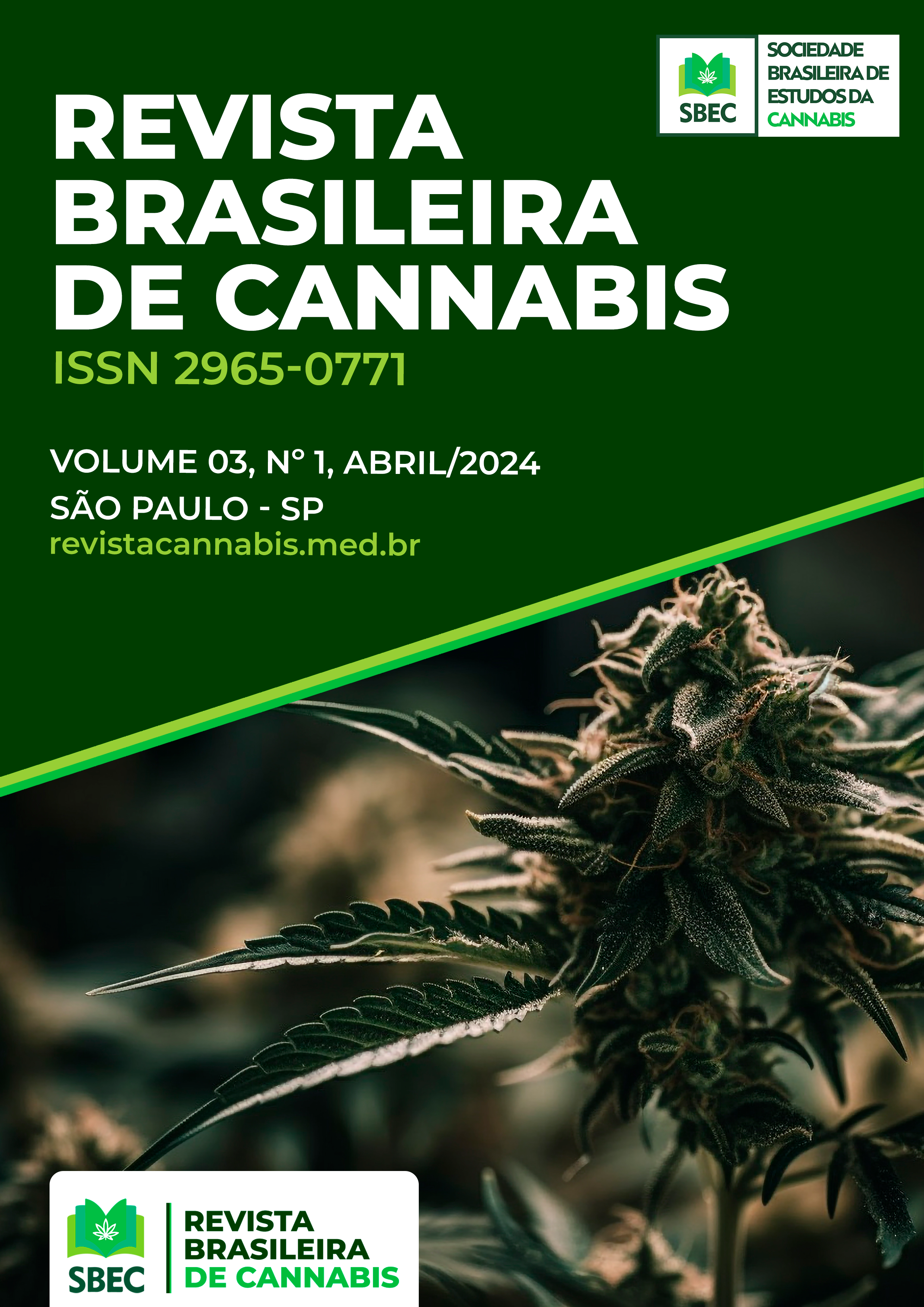Canabinoides na Dor Orofacial - Uma Revisão de Escopo
DOI:
https://doi.org/10.58731/2965-0771.2024.51Palavras-chave:
Cannabis, Dor Facial, Maconha MedicinalResumo
Antecedentes: Canabinóides seguros e eficazes da Cannabis Sativa L. mostram-se promissores como terapia complementar para dor crônica/aguda, inflamação, ansiedade e distúrbios do sono. Objetivo: O objetivo deste estudo é realizar uma revisão abrangente da literatura sobre o uso de canabinóides no tratamento da dor orofacial. Métodos: Esta revisão de escopo investiga o uso de canabinoides no tratamento da dor orofacial. Concentrou-se em artigos científicos publicados em revistas indexadas sem limite de data no PubMed/MEDLINE. Os pesquisadores definiram uma questão norteadora (“tratamento com canabinóides para dores orofaciais?”) e excluíram estudos não centralizados, editoriais e periódicos não indexados. Os revisores selecionaram independentemente os estudos e extraíram dados importantes para análise posterior. Resultados: Embora tenham sido considerados 833 artigos, apenas 11 preencheram os critérios (a maioria revisões sistemáticas recentes). Esses estudos tiveram origem em diversos países com foco em pesquisas dos últimos anos (2021-2022). Conclusão: Os canabinóides mostram-se promissores para a dor orofacial devido ao alívio da dor e à redução da inflamação, mas são necessárias mais pesquisas.
Referências
Li J, Carvajal R, Bruner L, Kaminski NE. The current understanding of the benefits, safety, and regulation of cannabidiol in consumer products. Food Chem Toxicol. 2021;157:112600.
Mlost J, Bryk M, Starowicz K. Cannabidiol for Pain Treatment: Focus on Pharmacology and Mechanism of Action. Int J Mol Sci. 2020;21(22):8870.
Grossman S, Tan H, Gadiwalla Y. Cannabis and orofacial pain: a systematic review. Br J Oral Maxillofac Surg. 2022;60(5):e677-e690.
Tricco AC, Lillie E, Zarin W, et al. PRISMA Extension for Scoping Reviews (PRISMA-ScR): Checklist and Explanation. Ann Intern Med. 2018;169(7):467-473.
Munn Z, Peters MDJ, Stern C, Tufanaru C, McArthur A, Aromataris E. Systematic review or scoping review? Guidance for authors when choosing between a systematic or scoping review approach. BMC Med Res Methodol. 2018;18(1):143.
Grossman S, Tan H, Gadiwalla Y. Cannabis and orofacial pain: a systematic review. Br J Oral Maxillofac Surg. 2022;60(5):e677-e690. doi:10.1016/j.bjoms.2021.06.005
Votrubec C, Tran P, Lei A, et al. Cannabinoid therapeutics in orofacial pain management: a systematic review. Aust Dent J. 2022;67(4):314-327.
Crescente G, Minervini G, Spagnuolo C, Moccia S. Cannabis Bioactive Compound-Based Formulations: New Perspectives for the Management of Orofacial Pain. Molecules. 2023; 28(1):106.
McDonough P, McKenna JP, McCreary C, Downer EJ. Neuropathic orofacial pain: cannabinoids as a therapeutic avenue. Int J Biochem Cell Biol. 2014;55:72-78.
Hossain MZ, Ando H, Unno S, Kitagawa J. Targeting Peripherally Restricted Cannabinoid Receptor 1, Cannabinoid Receptor 2, and Endocannabinoid-Degrading Enzymes for the Treatment of Neuropathic Pain Including Neuropathic Orofacial Pain. Int J Mol Sci. 2020;21(4):1423.
Haviv Y, Georgiev O, Gaver-Bracha T, et al. Reduced Endocannabinoid Tone in Saliva of Chronic Orofacial Pain Patients. Molecules. 2022;27(14):4662.
Heiliczer S, Wilensky A, Gaver T, et al. Salivary Endocannabinoid Profiles in Chronic Orofacial Pain and Headache Disorders: An Observational Study Using a Novel Tool for Diagnosis and Management. Int J Mol Sci. 2022;23(21):13017.
Vivanco-Estela AN, Dos-Santos-Pereira M, Guimaraes FS, Del-Bel E, Nascimento GCD. Cannabidiol has therapeutic potential for myofascial pain in female and male parkinsonian rats. Neuropharmacology. 2021;196:108700.
Almeida RT, Romero TR, Romero MG, de Souza GG, Perez AC, Duarte ID. Endocannabinoid mechanism for orofacial antinociception induced by electroacupuncture in acupoint St36 in rats. Pharmacol Rep. 2016;68(6):1095-1101.
Pereira EWM, Heimfarth L, Santos TK, et al. Limonene, a citrus monoterpene, non-complexed and complexed with hydroxypropyl-β-cyclodextrin attenuates acute and chronic orofacial nociception in rodents: Evidence for involvement of the PKA and PKC pathway. Phytomedicine. 2022;96:153893.
Pereira SR, Tello Velasquez J, Duggan S, et al. Recent advances in the understanding of the aetiology and therapeutic strategies in burning mouth syndrome: Focus on the actions of cannabinoids. Eur J Neurosci. 2022;55(4):1032-1050.
Golanska P, Saczuk K, Domarecka M, Kuć J, Lukomska-Szymanska M. Temporomandibular Myofascial Pain Syndrome-Aetiology and Biopsychosocial Modulation. A Narrative Review. Int J Environ Res Public Health. 2021 Jul 23;18(15):7807.
Downloads
Publicado
Como Citar
Edição
Seção
Licença
Copyright (c) 2025 Revista Brasileira de Cannabis

Este trabalho está licenciado sob uma licença Creative Commons Attribution 4.0 International License.





